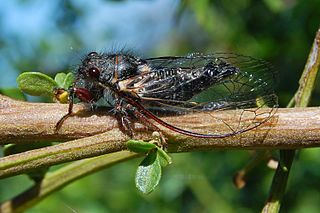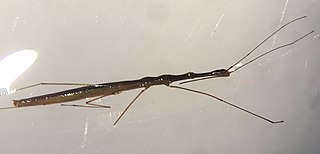
The Pentatomoidea are a superfamily of insects in the Heteroptera suborder of the Hemiptera order. As Hemiptera, they share a common arrangement of sucking mouthparts. The roughly 7000 species under Pentatomoidea are divided into 21 families. Among these are the shield bugs, giant shield bugs, burrower bugs, and stink bugs.

Beroe, commonly known as the cigar comb jellies, is a genus of comb jellies in the family Beroidae.

Polymerus is a genus of plant bugs in the family Miridae. There are at least 100 described species in Polymerus.
Buenoa is a genus of backswimmer. It was created by George Willis Kirkaldy in 1904 to include all species of Anisops from the Western Hemisphere with a two-segmented front tarsus in males, reserving the latter genus for Eastern Hemisphere species with a one-segmented front tarsus in males. It contains 69 described species.

Pelocoris is a genus of creeping water bugs in the family Naucoridae. There are about 15 described species in Pelocoris.

Platypedia is a genus of cicadas in the family Cicadidae. There are more than 20 described species in Platypedia.

Kalama tricornis, the gorse lacebug, is a species of lace bug in the family Tingidae.
Clidophleps is a genus of cicadas in the family Cicadidae. There are about eight described species in Clidophleps.
Gargaphia iridescens is a species of lace bug in the family Tingidae. It is found in Central America, North America, and South America.

Hydrometra australis is a species of water measurer in the family Hydrometridae. It is found in the Caribbean Sea, Central America, and North America.
Cornuplura is a genus of cicadas in the family Cicadidae. There are at least three described species in Cornuplura.
Hydrometra martini is a species of water measurer in the family Hydrometridae. It is found in North America.
Beameria is a genus of cicadas in the family Cicadidae. There are at least three described species in Beameria.
Cacama collinaplaga is a species of cicada in the family Cicadidae. It is found in North America.
Okanagodes is a genus of cicadas in the family Cicadidae. There are at least two described species in Okanagodes.

Pelocoris balius is a species of creeping water bug in the family Naucoridae. It is found in Florida.

Hermatobates is a genus of wingless marine bugs placed as the sole genus in the family Hermatobatidae that are sometimes known as coral-treaders. They are quite rare and known only from coral reefs in the Indo-Pacific region. During low tide, they move over the water surface not unlike the more familiar water-striders around coral atolls and reefs and stay submerged in reef crevices during high tide.
This list of fossil insects described in 2016 is a list of new taxa that were described during the year 2016, as well as other significant discoveries and events related to insect paleontology that are scheduled to occur in the year 2016.
This list of fossil insects described in 2015 is a list of new taxa that were described during the year 2015, as well as other significant discoveries and events related to insect paleontology that are scheduled to occur in the year 2015.
Burmese amber is fossil resin dating to the early Late Cretaceous Cenomanian age recovered from deposits in the Hukawng Valley of northern Myanmar. It is known for being one of the most diverse Cretaceous age amber paleobiotas, containing rich arthropod fossils, along with uncommon vertebrate fossils and even rare marine inclusions. A mostly complete list of all taxa described up until 2018 can be found in Ross 2018; its supplement Ross 2019b covers most of 2019.









